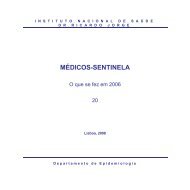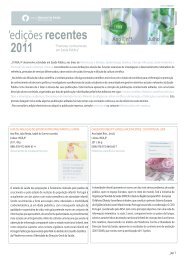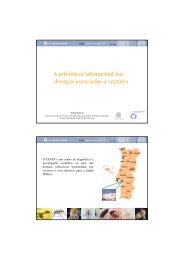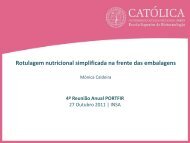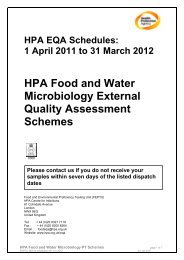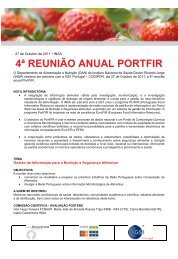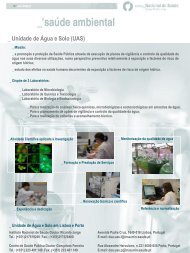European Society of Mycobacteriology - Instituto Nacional de Saúde ...
European Society of Mycobacteriology - Instituto Nacional de Saúde ...
European Society of Mycobacteriology - Instituto Nacional de Saúde ...
Create successful ePaper yourself
Turn your PDF publications into a flip-book with our unique Google optimized e-Paper software.
PP-31<br />
tuberculosis RESISTANCE in a general<br />
hospital in portugal – 9 years surveillance<br />
Sancho L.; Portugal C.; Tancredo L.; Silva M.; Dias A.; Silva F.; Sousa Germano<br />
Laboratory <strong>of</strong> Microbiology, Department <strong>of</strong> Clinical Pathology<br />
Hospital Fernando Fonseca – Amadora, Portugal<br />
luisasancho6@gmail.com<br />
Tuberculosis remains a serious public health problem in Portugal. In 2008, the Portuguese Health Authorities reported<br />
a TB inci<strong>de</strong>nce <strong>of</strong> 25,3/100.000 inhbitants (13,6% immigrants). TB Multi Drug Resistant (MDR) were 2,5%, 34% <strong>of</strong> which<br />
were Extensively Drug Resistant (XDR).<br />
Resistance to any <strong>of</strong> the primary drugs makes the disease more difficult and expensive to treat.<br />
Our Hospital is located in Lisbon’s surroundings and covers a population <strong>of</strong> 750.000 inhabitants most <strong>of</strong> them with poor<br />
socioeconomic level and immigrants from Africa and East Countries. In the Great Lisbon are located 66% <strong>of</strong> TB cases <strong>of</strong> Portugal.<br />
Purpose<br />
The aim <strong>of</strong> this study was to investigate the frequency <strong>of</strong> drug resistance <strong>of</strong> Mycobacterium tuberculosis Complex in a<br />
general Hospital in Amadora, Portugal, during a 9-year period (2000-2008).<br />
Methods<br />
A total <strong>of</strong> 19.417 clinical specimens (15.159 pulmonary and 4.261 extra pulmonary), collected from 9.525 patients, were<br />
cultured for mycobateria.<br />
Molecular genetic i<strong>de</strong>ntification <strong>of</strong> M.tuberculosis Complex and its resistance to Isoniazid and/or Rifampicin was ma<strong>de</strong><br />
with the technology Genotype MTBDR plus (HAIN-Lifecience-Germany).<br />
Antimycobacterial susceptibility test to the primary drugs, Streptomycin (STR), Isoniazid (INH), Rifampicin (RIF),<br />
Ethambutol (ETB) was performed in BACTEC MGIT 960 System<br />
Results<br />
In 19.417 cultured clinical specimens for mycobateria, 1094 (14,2%) were positive by cultural methods.<br />
1029 were i<strong>de</strong>ntified as M.tuberculosis Complex; 783 (76,1%) were strains without resistance, 150 (14,6%) with one resistance,<br />
73 (7.1%) were MDR, being more than 25% XDR.<br />
The proportion <strong>of</strong> M.tuberculosis strains resistance rate to antituberculosis drugs during the 9-year period was: Isoniazid<br />
11,1% (114), Streptomycin 20.2% (208)), Rifampicin 7.2% (74), and Ethambutol 4.7% (48); but in 2008 was: Isoniazid 4,8%,<br />
Streptomicin 17%, Rifampicin 4,1% and Etambutol 2%.<br />
On our tuberculosis population (661), in the last 6-years (2003-2008), we have compared the resistance rate related to<br />
3 parameters: sex, age and HIV.<br />
The tuberculosis (661) and MDR (38) populations have the same inci<strong>de</strong>nce rate: in male (67%) and in females (33%).<br />
The age distribution in the MDR population (38) was 0% [0-15], 5% [16-25], 29% [26-35], 39% [36-45], 13% [46-55], 11%<br />
[56-65], 0% [66-75], 3% [76-100]; and in patients without resistance (623) was 3% [0-15], 13% [16-25], 30% [26-35], 20%<br />
[36-45], 14% [46-55], 8% [56-65], 7% [66-75], 5% [76-100].<br />
The HIV parameter results were analysed on a 554 tuberculosis population. The MDR inci<strong>de</strong>nce rate for the HIV group<br />
(213) was 7%, and for the no HIV group (341) was 4%.<br />
Conclusion<br />
The level <strong>of</strong> resistance in our population (MDR 7%) is significantly higher than Portugal’s average (2,5%)<br />
The Multi Drug Resistance tends to be lower in the last years. The same can be observed in each <strong>of</strong> the tested drugs.<br />
HIV infection, age and sex patient are factors that contributed to the variation <strong>of</strong> tuberculosis/MDR inci<strong>de</strong>nce rate.<br />
Comparing the resistance rate by sex parameter, we didn’t found differences for tuberculosis or MDR populations; they<br />
both have a bigger inci<strong>de</strong>nce in the male sex (67%).<br />
The major inci<strong>de</strong>nce <strong>of</strong> tuberculosis is among active population, between 26 and 45 years old, but, it is between 36 and 45<br />
that we found most <strong>of</strong> the MDR strains (39% <strong>of</strong> all), mostly because <strong>of</strong> drug abuse and HIV infection in this age group.<br />
The inci<strong>de</strong>nce <strong>of</strong> MDR tuberculosis is clearly bigger in HIV positive (7%) than in HIV negative (4%).<br />
Discussion<br />
In spite <strong>of</strong> our population have a level <strong>of</strong> resistance above the Portuguese average, we noted that the number <strong>of</strong> tuberculosis<br />
cases, including MDR, <strong>de</strong>creased 7,8% during this 9-year period analysed, which is comparable to 2008 national<br />
data (-7.2% in the last <strong>de</strong>ca<strong>de</strong>).<br />
<strong>European</strong> <strong>Society</strong> <strong>of</strong> <strong>Mycobacteriology</strong> | 30 th Annual Congress | July 2009 | Porto - Portugal<br />
103



